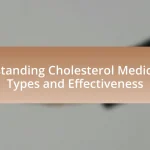The article focuses on recent advancements in cholesterol treatment, highlighting new classes of medications such as PCSK9 inhibitors and inclisiran, which significantly lower LDL cholesterol levels and improve patient adherence. It discusses how these innovations have transformed treatment approaches, particularly for patients who are statin-intolerant, and emphasizes the importance of personalized medicine strategies. Additionally, the article outlines the impact of these new treatments on patient outcomes, the necessity for patients to stay informed, and practical steps for effective cholesterol management, including lifestyle changes and self-advocacy in healthcare discussions.

What are the New Developments in Cholesterol Treatment?
Recent developments in cholesterol treatment include the introduction of new classes of medications such as PCSK9 inhibitors, which significantly lower LDL cholesterol levels. Clinical trials have demonstrated that these drugs can reduce cardiovascular events by up to 50% in high-risk patients. Additionally, novel therapies like inclisiran, an RNA interference therapy, have shown promise in reducing LDL cholesterol with less frequent dosing, potentially improving patient adherence. These advancements are supported by studies published in journals such as the New England Journal of Medicine, highlighting their efficacy and safety profiles.
How have recent advancements changed cholesterol treatment approaches?
Recent advancements have significantly transformed cholesterol treatment approaches by introducing new classes of medications, such as PCSK9 inhibitors and bempedoic acid, which provide alternative options for patients who are statin-intolerant or require additional LDL cholesterol lowering. These innovations have been supported by clinical trials demonstrating that PCSK9 inhibitors can reduce LDL cholesterol levels by up to 60% and lower cardiovascular events, as evidenced by studies like the FOURIER trial. Additionally, the development of personalized medicine strategies, including genetic testing for familial hypercholesterolemia, allows for more tailored treatment plans, enhancing the effectiveness of cholesterol management.
What new medications are available for cholesterol management?
New medications available for cholesterol management include PCSK9 inhibitors, such as evolocumab and alirocumab, which significantly lower LDL cholesterol levels. These medications work by inhibiting the PCSK9 protein, leading to increased clearance of LDL cholesterol from the bloodstream. Clinical trials have demonstrated that these drugs can reduce LDL cholesterol by up to 60% and have been shown to lower the risk of cardiovascular events in high-risk patients. Additionally, bempedoic acid is a new oral medication that targets cholesterol synthesis in the liver, providing another option for patients who cannot tolerate statins.
How do these medications differ from traditional treatments?
These medications differ from traditional treatments primarily in their mechanism of action and efficacy. Traditional cholesterol treatments, such as statins, primarily work by inhibiting cholesterol synthesis in the liver, whereas newer medications, like PCSK9 inhibitors, enhance the liver’s ability to remove LDL cholesterol from the bloodstream. Clinical studies have shown that PCSK9 inhibitors can reduce LDL cholesterol levels by up to 60%, significantly more than the average 30-50% reduction achieved with statins. This difference in effectiveness can lead to better cardiovascular outcomes for patients at high risk of heart disease.
Why is it important for patients to stay informed about these developments?
It is important for patients to stay informed about developments in cholesterol treatment because this knowledge enables them to make informed decisions regarding their health management. Staying updated allows patients to understand new medications, treatment protocols, and lifestyle changes that can significantly impact their cholesterol levels and overall cardiovascular health. For instance, recent advancements in cholesterol-lowering therapies, such as PCSK9 inhibitors, have shown to reduce LDL cholesterol levels by up to 60%, which can lead to a lower risk of heart disease. By being aware of these developments, patients can engage in meaningful discussions with their healthcare providers, ensuring they receive the most effective and personalized treatment options available.
What impact do new treatments have on patient outcomes?
New treatments significantly improve patient outcomes by enhancing cholesterol management and reducing cardiovascular risks. For instance, recent advancements in cholesterol-lowering therapies, such as PCSK9 inhibitors, have been shown to reduce LDL cholesterol levels by up to 60%, leading to a 20-25% decrease in the risk of heart attacks and strokes, as evidenced by clinical trials like the FOURIER study. These innovations not only provide more effective options for patients who are statin-resistant but also contribute to overall better health metrics and quality of life for individuals at risk of cardiovascular diseases.
How can patients access information about these advancements?
Patients can access information about advancements in cholesterol treatment through various reliable sources. These sources include healthcare providers, who can offer personalized insights and updates on new treatments, as well as reputable medical websites and journals that publish research findings and clinical guidelines. For instance, organizations like the American Heart Association and the National Institutes of Health provide comprehensive resources on cholesterol management and emerging therapies. Additionally, attending patient education seminars or support groups can facilitate access to the latest information and foster discussions with healthcare professionals and peers.

What Should Patients Watch For in Cholesterol Treatment?
Patients should watch for potential side effects and changes in cholesterol levels during cholesterol treatment. Common side effects include muscle pain, liver enzyme changes, and gastrointestinal issues, which can indicate adverse reactions to medications such as statins. Regular monitoring of lipid profiles is essential, as studies show that approximately 30% of patients may not achieve target cholesterol levels despite treatment. Additionally, patients should be aware of lifestyle factors, such as diet and exercise, that can significantly impact treatment efficacy.
What are the key signs that a new treatment may be beneficial?
Key signs that a new treatment may be beneficial include a significant reduction in cholesterol levels, improved lipid profiles, and a decrease in cardiovascular events. Clinical trials often demonstrate these outcomes, with studies showing that treatments leading to a 20% or greater reduction in LDL cholesterol are associated with a lower risk of heart disease. Additionally, patient-reported improvements in symptoms and overall health can indicate the effectiveness of the treatment. For instance, research published in the Journal of the American College of Cardiology highlights that new cholesterol-lowering therapies can lead to measurable improvements in both clinical and patient-reported outcomes, reinforcing the potential benefits of these treatments.
How can patients recognize when their current treatment is ineffective?
Patients can recognize when their current cholesterol treatment is ineffective by monitoring their cholesterol levels and observing any persistent symptoms related to high cholesterol, such as chest pain or fatigue. Regular blood tests can reveal whether LDL cholesterol levels remain elevated despite treatment; for instance, a target LDL level is often below 100 mg/dL, and levels above this may indicate treatment failure. Additionally, if patients experience side effects or do not notice improvements in their overall health, it may signal that the treatment is not working effectively.
What symptoms should prompt a discussion with a healthcare provider?
Symptoms that should prompt a discussion with a healthcare provider include chest pain, shortness of breath, unexplained fatigue, and persistent headaches. These symptoms may indicate underlying cardiovascular issues, which are particularly relevant in the context of cholesterol treatment. For instance, chest pain can signal angina or a heart attack, while shortness of breath may suggest heart failure or other serious conditions. Unexplained fatigue can be a sign of poor circulation or heart disease, and persistent headaches could indicate hypertension or other vascular problems. Recognizing these symptoms early can lead to timely intervention and better management of cholesterol levels and overall heart health.
How can patients evaluate the effectiveness of their cholesterol treatment?
Patients can evaluate the effectiveness of their cholesterol treatment by regularly monitoring their cholesterol levels through blood tests, specifically measuring LDL (low-density lipoprotein) and HDL (high-density lipoprotein) cholesterol. These tests provide concrete data on how well the treatment is working, as a decrease in LDL levels and an increase in HDL levels typically indicate effective treatment. According to the American Heart Association, patients should aim for an LDL level of less than 100 mg/dL for optimal heart health, and regular follow-ups with healthcare providers can help assess progress and make necessary adjustments to treatment plans.
What metrics should patients monitor to assess treatment success?
Patients should monitor their cholesterol levels, specifically low-density lipoprotein (LDL) and high-density lipoprotein (HDL) cholesterol, to assess treatment success. Tracking these metrics helps determine if the treatment effectively lowers harmful LDL cholesterol while increasing protective HDL cholesterol. Clinical guidelines recommend regular lipid panel tests, typically every 4 to 12 weeks after starting or adjusting treatment, to evaluate these levels. Studies indicate that achieving target LDL levels significantly reduces cardiovascular risk, validating the importance of monitoring these specific cholesterol metrics.
How often should patients consult with their healthcare provider about treatment options?
Patients should consult with their healthcare provider about treatment options at least once every three to six months, especially when managing conditions like high cholesterol. Regular consultations allow for timely adjustments to treatment plans based on the latest research and individual health changes. For instance, the American Heart Association recommends regular follow-ups to monitor cholesterol levels and assess the effectiveness of prescribed therapies, ensuring that patients receive optimal care tailored to their evolving health needs.

What Resources are Available for Patients Regarding Cholesterol Treatment?
Patients have access to various resources regarding cholesterol treatment, including educational websites, support groups, and healthcare provider consultations. Educational websites such as the American Heart Association and the National Lipid Association offer comprehensive information on cholesterol management, treatment options, and lifestyle changes. Support groups provide a platform for patients to share experiences and gain emotional support. Additionally, healthcare providers can offer personalized advice and treatment plans based on individual health needs, ensuring that patients receive tailored care.
Where can patients find reliable information about cholesterol treatments?
Patients can find reliable information about cholesterol treatments through reputable medical websites, such as the American Heart Association and the National Institutes of Health. These organizations provide evidence-based guidelines and updates on cholesterol management, including the latest research and treatment options. For instance, the American Heart Association offers resources that detail dietary recommendations, medication options, and lifestyle changes that can effectively manage cholesterol levels.
What role do healthcare professionals play in educating patients?
Healthcare professionals play a crucial role in educating patients by providing them with essential information about their health conditions, treatment options, and preventive measures. They facilitate understanding of complex medical concepts, ensuring patients are informed about new developments in cholesterol treatment, such as the latest medications and lifestyle changes that can impact their health. Research indicates that effective patient education can lead to improved health outcomes, as patients who are well-informed are more likely to adhere to treatment plans and make healthier lifestyle choices. For instance, a study published in the Journal of the American College of Cardiology found that patients who received comprehensive education about cholesterol management had significantly better control of their cholesterol levels compared to those who did not receive such education.
How can online resources assist patients in understanding their treatment options?
Online resources assist patients in understanding their treatment options by providing accessible, evidence-based information about cholesterol treatments. These resources, such as medical websites, online forums, and educational videos, offer detailed explanations of various treatment modalities, including lifestyle changes, medications, and emerging therapies. For instance, the American Heart Association provides guidelines and research updates that help patients comprehend the latest advancements in cholesterol management. Additionally, online platforms enable patients to compare treatment options, read patient testimonials, and engage with healthcare professionals, enhancing their ability to make informed decisions about their health.
What practical steps can patients take to manage their cholesterol effectively?
Patients can manage their cholesterol effectively by adopting a heart-healthy diet, engaging in regular physical activity, and adhering to prescribed medications. A heart-healthy diet includes reducing saturated fats found in red meat and full-fat dairy products, eliminating trans fats found in many processed foods, and increasing intake of omega-3 fatty acids from fish, which can lower triglyceride levels. Regular physical activity, such as 150 minutes of moderate aerobic exercise per week, can help raise high-density lipoprotein (HDL) cholesterol, the “good” cholesterol. Additionally, patients should take medications as prescribed, such as statins, which have been shown to lower low-density lipoprotein (LDL) cholesterol, the “bad” cholesterol, and reduce the risk of heart disease. According to the American Heart Association, lifestyle changes combined with medication can significantly improve cholesterol levels and overall cardiovascular health.
What lifestyle changes can complement new cholesterol treatments?
Lifestyle changes that can complement new cholesterol treatments include adopting a heart-healthy diet, increasing physical activity, maintaining a healthy weight, quitting smoking, and managing stress. A heart-healthy diet emphasizes fruits, vegetables, whole grains, and healthy fats while reducing saturated fats, trans fats, and cholesterol intake. Regular physical activity, such as 150 minutes of moderate exercise per week, can help lower LDL cholesterol and raise HDL cholesterol. Maintaining a healthy weight is crucial, as losing even a small amount of weight can improve cholesterol levels. Quitting smoking has immediate benefits for heart health, and managing stress through techniques like mindfulness or yoga can also positively impact cholesterol levels. These lifestyle modifications are supported by research indicating that they can enhance the effectiveness of cholesterol-lowering medications and improve overall cardiovascular health.
How can patients advocate for themselves in discussions about treatment options?
Patients can advocate for themselves in discussions about treatment options by preparing questions and actively engaging in conversations with healthcare providers. This involves researching their condition and potential treatments, which empowers patients to make informed decisions. Studies show that patients who ask questions and express their preferences are more likely to receive personalized care and better outcomes. For instance, a survey published in the Journal of Patient Experience found that 70% of patients felt more satisfied with their care when they participated in treatment discussions.










